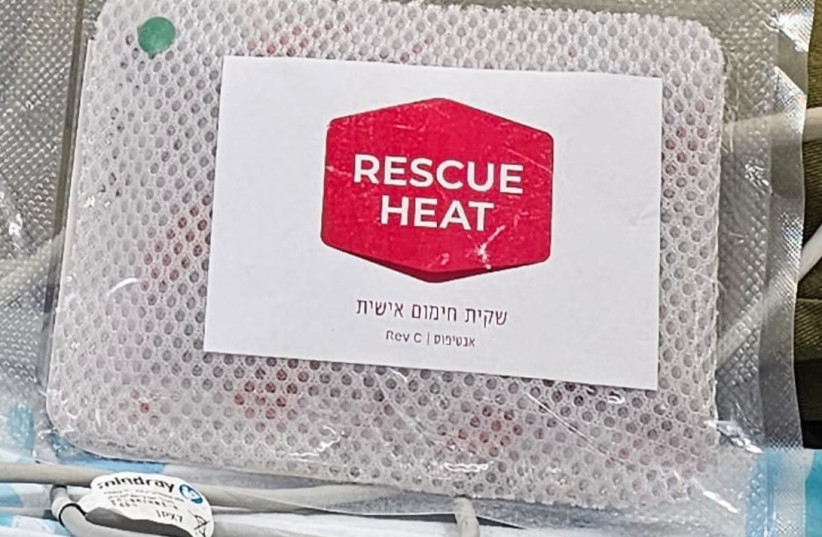As the Gaza war against Hamas slips into winter, an innovative Israeli development that could save wounded who fought or were injured in a hostile environment has been developed at Haifa’s Rambam Health Care Campus.
When there is a drop in the body temperate of wounded soldiers and civilians dealing with a drop in body temperature following exposure to cold and bleeding, a smart “patch” that quickly heats up to exactly 42 degrees, is placed on the injured skin and retains this heat for a long time.
The first supplies have already been delivered to the IDF for soldiers on the battlefield.
One of the dangers associated with injury and blood loss is hypothermia – a rapid drop in body temperature. Called Rescue Heat, the product was developed by Hagay Weisbrod, CEO of the biomedical engineering company Noyad Biomed at Kibbutz Lavi in the Galilee (a reservist in the paratroopers), and Dr. Amit Lehavi, director of Rambam’s pediatric anesthesia unit (a military physician and the company’s medical advisor).
The goals of the innovation
The innovation is meant to rewarm the body, prevent the deterioration of the injured, and save lives. The technology has successfully passed feasibility tests in the lab and on healthy human skin. The need for this type of solution, for efficient, fast, and safe heat transfer, was proven in a comprehensive study led by Dr. Lehavi to which other leading methods of maintaining body temperature were compared.
These were proven inefficient and a a greater risk of burns compared to the patch developed by Rescue Heat.
“In situations of trauma, such as an injury on the battlefield, the body may go into shock and lose heat for various reasons, such as the loss of blood itself, the loss of the ability to maintain body heat by constricting peripheral blood vessels, and sometimes just lying on the cold ground,” noted Lehavi who, as part of his military role, has taken part in a large number of rescue and rescue missions in disaster areas.

“As soon as the body temperature drops below 35 degrees Celsius, the body enters a state of stress, and various systems of the body stop functioning properly. The main danger in these situations is that hypothermia impairs blood clotting, as a result of which the bleeding does not stop and the danger to life increases,” he added.
The dangers of hypothermia on the battlefield
Each year, 20 million trauma victims are hospitalized in the US alone, of which two-thirds are also diagnosed as hypothermia victims. In Lehavi’s lab, an assessment was made of most of the heating products available today. In a study conducted in the laboratory comparing five different technologies for active heating and five passive methods for preventing heat loss, the thermal patch showed a much higher efficiency potential than the other methods tested.
Research showed a significant improvement in all the indicators of the patients who received the heating, including a quick recovery and a faster discharge from the hospital.
Adi Shalev, vice president of operations at Noyad Biomed and manager of the Rescue Heat project explained that the innovative heating patch at the core of the product was developed to prevent hypothermia even before evacuation to the hospital, The heating material, which was registered as a patent, begins to act when it is shaken and exposed to air.
The bag heats up to a temperature of 42 degrees Celsius within 15 minutes of its activation and maintains the temperature for eight hours.
The patch consists of a “smart” material attached to the body and designed so that it heats the cold skin up to a temperature of 42 degree and not warmer than that. The transfer of heat is much more efficient compared to the alternatives that exist today when the goal is to keep the injured in a normal temperature range of 37 degrees Celsius.
The direct adhesion optimizes the transfer of heat tenfold compared to the products currently used in the field, said Shalev and Lehavi, adding that the patch is meant to be a supplement to the normal treatment protocol for the wounded and does not require adjustments or changes in the conduct of the medics in the field.
The developers hope to prove that the temperature can be maintained for eight hours, compared to 90 minutes and even less with other methods.
“So far, we have already transferred units of the thermal sticker to the IDF to be tested by selected units in the field. We hope that the development can help save lives,” they concluded
